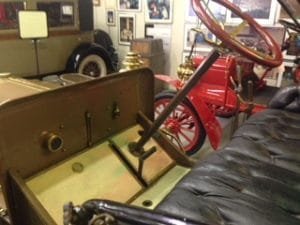The automobile featured in this article is an original 1908 Maxwell Model LC. This model is an excellent example of the brass era of automobiles. This was a period during the very late 1800’s to the early 1900’s. The brass era refers to the time when brass fittings such as radiators, horns and headlamps among other car parts were used prominently. This was also the first era of auto manufacturing.

The Maxwell Automobile
The Maxwell was a brand of automobiles manufactured in the United States of America from about 1904 to 1925. Of historic significance is that the Maxwell company is the predecessor of today’s Fiat Chrysler automobiles.
Maxwell began in 1904 as the Maxwell-Briscoe Motor Company, using the former Mobile Steamer factory in Tarrytown, New York. The founders of the company were Jonathan Dixon Maxwell, and Benjamin Briscoe. Maxwell had performed work with Oldsmobile and Briscoe had spent some time with Buick. The start up company’s financing largely came from J.P. Morgan.
In 1909, Maxwell-Briscoe was the third largest American automaker, with 9,400 sales per year, and $3 million profit since the company’s founding. To help promote how sturdy and relaible their cars were, Maxwell sponsored a historic national cross-country drive, the first such drive by a woman with a female mechanic.

To give you an idea of how the Glidden Tour operated….the 1908 Tour had rules where each automobile was to carry an observer. The observer would note every repair and adjustment and basically everything that involves their assigned car. Points are taken away for each repair and/or adjustment needed and failure to run on schedule. The Glidden Trophy was awarded to the car club that lost the fewest points.
The United States Motor Company
General Motors under William Durant was unsuccessful in bringing the Maxwell Briscoe Motor Company into the GM fold. Maxwell-Briscoe however did believe they needed to merge with a competitor to stay competitive. The end result was the start of the United States Motor Company.
The Maxwell-Chrysler Connection
The first Maxwell car was made in 1904 by Jonathan Maxwell and Benjamin Briscoe, who in 1909 joined the short-lived United States Motor Company.This was a combination of several automakers including Maxwell, Brush Motor Car Company, Alden Sampson Trucks, Stoddard-Dayton, Columbia Automobile Company, Briscoe Manufacturing and others. The idea of this merger was to help these automakers financially. Obtaining bank financing was not easy and the feeling was that there was strength in numbers. One problem with this particular arrangement was that only Maxwell was operating profitably.
The United States Motor Company folded in 1913 but Maxwell, being profitable, continued on alone until the post World War One recession. In 1920, owing a great deal of money to creditors, Maxwell connected with Walter P. Chrysler, who had resigned from the Buick division of General Motors. The purpose was to try to save the company. In 1922 the Maxwell company took over Chalmers Motor Car Co. In 1923 Walter Chrysler bought control of Maxwell.
Under Walter Chrysler’s leadership, the company began to produce more competitive automobiles. The company introduced a revolutionary six-cylinder vehicle that was showcased at the 1924 New York Automobile Show. In 1925 the Maxwell Motor Company was renamed as the Chrysler Corporation, with Walter P. Chrysler as it’s president. The Maxwell automobile would be the car that eventually became the Plymouth brand under Chrysler.
The 1908 Maxwell Specifications
The 1908 Maxwell was a very popular automobile. Popular enough that it came in third in sales behind Ford and Buick. The reputation was as a sturdy automobile with simple but excellent engineering.

The 1908 Maxwell Model LC was built with a horizontally opposed 2 cylinder 14 HP engine. The engine used a chain drive.
The car had a three speed gearbox and an all steel body.
This model was a part of the Brass Era with it’s brass headlamps, horn, radiator and tail light.
You may enjoy the additional Auto Museum Online articles found on the links below…
 The 1908 Maxwell Model LC was a lightweight vehicle for two and was one of the first automobiles to use a steering wheel as opposed to a tiller. The Model LC was the entry level Maxwell. There was a 1908 Maxwell Model D that was a five passenger vehicle with a carriage top. The Model D had a straight four cylinder engine and a 104.0 inch wheelbase.
The 1908 Maxwell Model LC was a lightweight vehicle for two and was one of the first automobiles to use a steering wheel as opposed to a tiller. The Model LC was the entry level Maxwell. There was a 1908 Maxwell Model D that was a five passenger vehicle with a carriage top. The Model D had a straight four cylinder engine and a 104.0 inch wheelbase.
The 1908 Maxwell LC came in one body style. The designation LC was only used for the 1908 model year.
Maxwell Collector Cars
 Any Maxwell automobile still in existence is a rare model. When you come across one the Brass Era models with it’s eye-catching brass fittings, it will get your attention.
Any Maxwell automobile still in existence is a rare model. When you come across one the Brass Era models with it’s eye-catching brass fittings, it will get your attention.
As of this writing early Maxwell collector automobiles, while being quite rare, are priced reasonably. At auction, the 1908 Maxwell Model LC averaged about $18,500. Depending on condition and restoration, the range can be from about $15,000 to the mid $20,000 area.
References for this article include…The Indianapolis News…Maxwell Motor and the Making of the Chrysler Corporation by author Anthony J. Yanik…Complete History of Chrysler Corporation, 1924-1985.
(Article and photos copyright Auto Museum Online)
